�
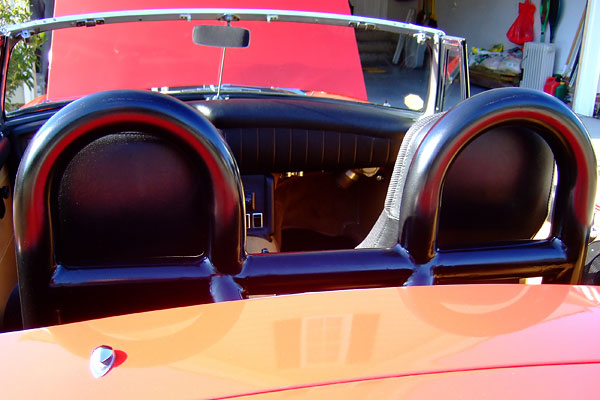
�
How To: Build a Do-It-Yourself Roll Hoop for your MGB
��
as published in BritishV8 Magazine, Volume XIX Issue I, December 2011�
�
by: Don Bode�
�
Now that I had created a vehicle that was capable of transporting the driver and possibly�
a fool hardy passenger to the edge of sanity within seconds - all while staying under the�
posted speed limit of course! - I definitely felt a need for dependable rollover protection.�
Searching suppliers for a ready-made product produced tall boxy looking (though SCCA approved)�
structures that are far from complementary to the timeless styling of the MGB!�
An additional version was located that was one step closer to conforming to the shape of�
the seats, yet sported two over sized hoops so as to appear generic in design.�
�
Realizing my options were quickly limited to designing and fabricating a satisfactory�
unit to personal preferences. My requirements were basic:
�
(1) strong design and construction,
�
(2) readily appear to be custom made for an MGB with Miata style seats,
�
(3) retain access to the MGB's battery compartments,
�
(4) retain use of the convertible top.�
�
Taking a sketch of my initial design concept to a local race/show car builder, I was�
promptly presented with an estimate of $2,750.00! And I was further told the desired�
tubing could not be bent in a small enough shape to "shadow" the profile of the seats!�
�
�
While still trying to accept defeat, I happened upon a bicycle rack at a local school�
that to me appeared to encompass the shapes, bends and even the size of tubing that could�
possibly be reconfigured into a roll bar for the MGB!�
�
I wasted no time contacting the manufacturer. Their name plate was attached to the bike rack:�
www.DuMor.com and I was told that I'd have to go through�
one of their dealers. While questioning the purpose of the inquiry, they readily provide me�
with the name of a dealer in my area. With that, a powder-coated "five bike" version was�
purchased. (I don't recommend the galvanized steel version because welding galvanized steel�
creates very toxic fumes.) The bike rack was soon delivered by an eighteen wheel freight�
delivery truck to my home shop and I was on my way!�
�
�
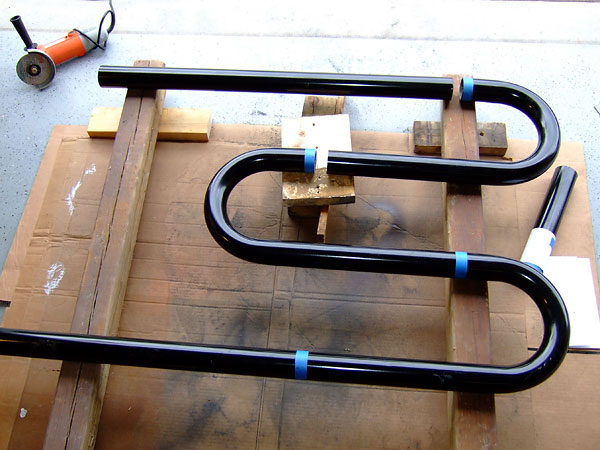
�
The DuMor "Five Bike" Bicycle Rack, Part Number 130-20
�
�
The steel pipe used in the construction of the DuMor bike rack is 2 3/8" outside diameter with a 5/16"�
wall thickness. While I wanted my roll hoops to conform to the shape of my seats - resembling those�
available for Miata or BMW roadsters - they could easily be constructed taller. This photo�
illustrates how the "hoops" and necessary braces were all cut from the original product.�
�
�
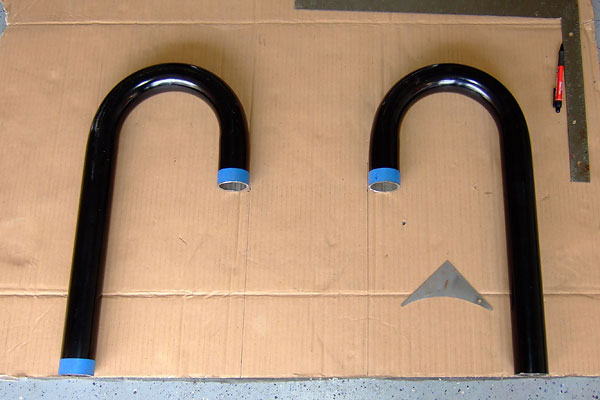
�
Double Hoops - Separated
�
�
This view shows the parts being extracted from the original bike rack to begin morphing�
into a roll bar.�
�
�
Enjoying this article? Our magazine is funded through the generous support of readers like you!
�
To contribute to our operating budget, please click here and follow the instructions.
�
(Suggested contribution is twenty bucks per year. Feel free to give more!)�
�
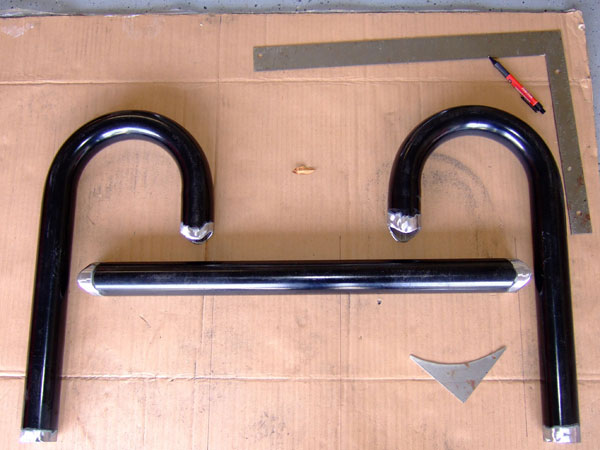
�
Double Hoops with Brace, Prepped
�
�
This shot shows the pieces being prepared for welding together. A "tube notching" tool is�
very helpful at this stage to produce strong, smooth joints. The rack is delivered with a�
powder coat finish that must be ground away for a strong weld. However, the manufacturer does�
include a can of paint for touching up the welds if desired.�
�
�
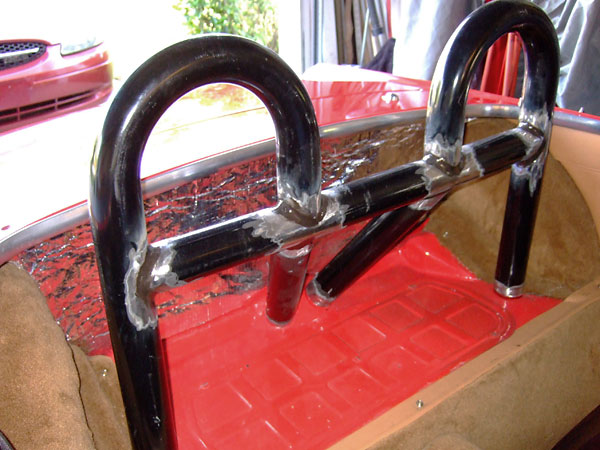
�
Trial Fit (without brackets)
�
�
The bike rack turned roll hoop is now trial-fitted into the vehicle to insure proper positioning�
of the mounting points while ensuring access to the battery compartment has been retained.�
The convertible top was also installed at this step to be sure the top could still be utilized�
without any alterations.�
�
�
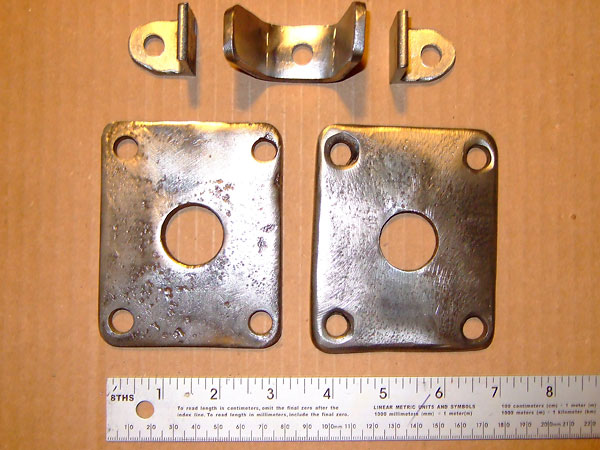
�
Roll Hoop Mounting Brackets
�
�
This is a view of the inside floor mounting brackets. A sharp eye might see that the two�
large rectangular floor mounting plates were actually the lower plates that at one time were�
used in securing the rear leaf springs to the axle housing. The three small brackets are to be�
welded to the two rear support braces, which will connect the two braces and then secure the�
assembly to the differential hump in the floor.�
�
�
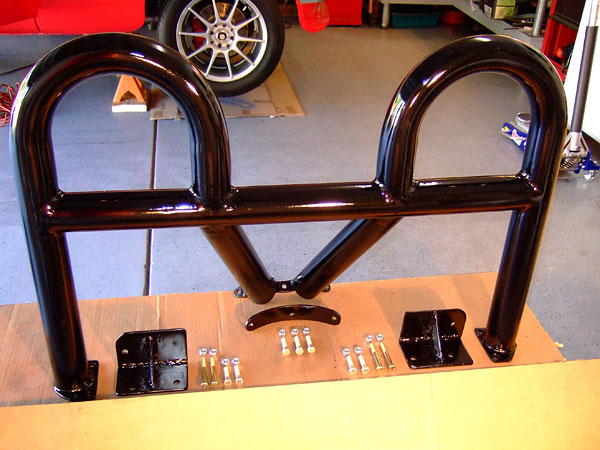
�
Complete Roll Hoop Assembly, including Mounting Hardware
�
�
This photo shows the layout of the roll bar with the inside floor brackets mounted. The remaining�
three brackets shown are used in supporting the strengthening of the three mounting points. The�
two larger brackets bolt underside to the frame, using the mounting holes from the original shock�
absorbers that were removed in favor of modern air assist shocks.�
�
�
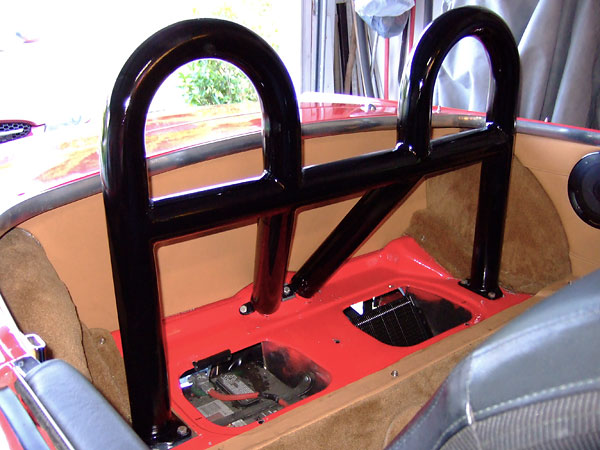
�
Roll Bar Mounted in MGB
�
�
After the placement was once more confirmed, the roll bar assembly was secured to the floor and�
frame using the underside reinforcement brackets joined using course thread SAE Grade 8 bolts.�
Once the assembly is mounted, it not only results in roll over protection for the occupants but�
forms a strong, integral cross bracing that supplements the vehicle's unibody.�
�
�
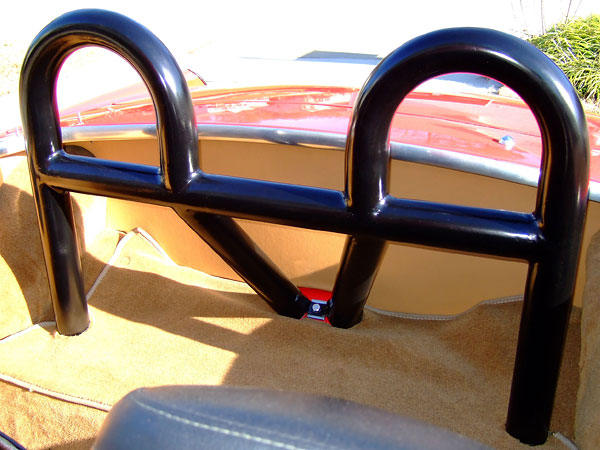
�
Roll Bar Installed, with Carpet
�
�
The carpet covering the access cover is then partially snapped into place before cutting holes�
for the three mounting points. Extreme caution should be exercised at this stage to avoid replacing�
a section of the carpet! Using a sharp cutting tool (box cutter, carpet knife, etc.), begin by�
cutting a hole about one-fourth the size of the roll bar tubing. Then, gradually enlarge the hole�
while doing any minor repositioning as necessary until the carpet fits snuggly and wrinkle-free�
around the tubing.�
�
The photo at the very top of this article shows how the cross brace aligns with the level of the�
body while forming a "shadow contour" of the head rest of the Mazda Miata bucket seat. The height�
of the hoops are of course a personal preference, and can be altered in step one when cutting�
out the individual hoops from the bike rack. (Race sanctioning organizations require�
taller roll hoops to accommodate helmet-wearing heads. If your car's seats don't have integral�
headrests, your roll hoop will obviously require padding.) While no rollover hoop provides absolute�
protection in the event of a vehicle roll over, the bicycle-rack roll hoop is cost efficient,�
very robust, and stylish too! �
�
| �
What's the Difference?�
� by: Curtis Jacobson� � Readers who aspire to road race their sports cars would be well advised to check club rules before� constructing or fitting any sort of rollover protection. As Don noted in the very first paragraph of� his article, roll hoops constructed to meet Sports Car Club of America rules tend to be "tall boxy� looking structures that are far from complementary to the timeless styling of the MGB." They actually� differ in more ways than just height or shape. It might be instructive to look briefly at the SCCA� rules.� � First of all, SCCA is rather specific about tubing: they require seamless or DOM (drawn over� mandrel) tubing. DuMor bicycle racks are made from Schedule 40 steel pipe, which has a longitudinal� welded seam. Furthermore, SCCA gives roll hoop fabricators a choice between mild steel (specifically� SAE 1010, 1020, or 1025 alloys) or Chrome-Moly alloy steel (specifically SAE 4130) tubing.� The steel used in Schedule 40 pipe may or may not equate to one of SCCA's explicitly specified� mild steel options; but it very likely has a higher carbon content.� � To keep weight down, racers tend to select thin wall tubing. For a production-class racecar weighing� between 1500 and 2500 pounds, the minimum size mild steel tubing allowed by SCCA is 1.50" diameter by� 0.095" wall thickness. (Chome-Moly steel alloys have a higher tensile strength. If 4130 tubing is used,� SCCA allows smaller minimum dimensions: 1.375" diameter by 0.095".) By comparison, with a 2.375" outside� diameter and a beefy 0.3125" wall thickness, Don's Schedule 40 roll hoops are huge! At every joint,� including especially at mounting brackets, a larger weld area equates to a stronger intersection.� Consider the difference in weld length: ~4.712" around the circumference of a 1.5" diameter tube versus� ~7.461" around a 2.375" diameter pipe equates to over 58 percent more weld length. (Weld depth may be� more too.) In summary, the bicycle-rack roll hoops are made from inferior material but there's much� more of it.� � SCCA's rules are a minimum standard; some racers prefer to go a size larger. For example, by� substituting 1.75" diameter tubing for 1.5" diameter tubing they get a much stronger roll cage.� In this example, every single welded joint is stronger by at least seventeen percent. � � Other racer's take a different approach: they buy into the promise of a stronger and lighter� roll structure made from Chrome-Moly steel alloy tubing. I'm going to digress to explain my� strong opinion that almost everyone should avoid using 4130 for safety-related welded fabrications� because generally welds in 4130 require heat treatment. They can reduce but not fully eliminate� the need for heat treatment by selecting a filler rod that dilutes the alloy level in the weld� zone (e.g. ER70S-2), but doing so reduces tensile and yield strength of the weld substantially.� Racers who select Chrome-Moly generally specify a smaller tube diameter to save weight, but with� the smaller diameter they get a smaller weld area. Smaller weld area combined with diluted alloy� typically produces a weaker joint than if they'd simply used mild steel for the whole assembly.� On the other hand, if they select a filler material that doesn't dilute the weld (i.e. a 4130 rod)� or one that dilutes it less (e.g. ER80S-D2), heat treatment is critical. If heat treatment is� skipped or performed poorly, the resulting structure will be much more likely to brake when� impacted than a comparable mild steel structure despite the higher strength rating and very� large price premium of Chrome-Moly! There are much more cost-effective ways to make a racecar� light and quick - and safer - so amateur racers would be wise to leave Chrome-Moly to� professional race teams.� � For several decades, SCCA roll cage specifications have mandated generous survival space� for helmeted racers in the event of rollovers. The idea of roll hoop that follows headrest� shape is anathema to their way of thinking: "roll hoops should be wide." In sharp contrast,� a key reason Don was attracted to DuMor's bicycle racks as a source of material was the small� radius of their bends. The SCCA General Competition Rules are specific: "The radius of bends� in the roll cage hoop (measured at centerline of tubing) shall not be less than three (3) times� the diameter of the tubing." In the context of a wide main hoop, a tight bend is generally� more likely to deform significantly on impact. � � There are many other rules, for example relating to the placement and geometry of bracing, but it� probably wouldn't be productive to list them here. The "take away point" is that there really� are significant differences between the roll hoops we generally see on street cars and the� roll cages used on race cars. We can learn from the latter, even if we don't choose to� emulate them.� � | � |
� Disclaimer: The two articles on this page were researched and written by Don Bode and by Curtis Jacobson� respectively. Views expressed are those of the respective authors, and are provided without warrantee or guarantee.� Apply at your own risk.�
� Photos by Don Bode for BritishV8 Magazine. All rights reserved. �

